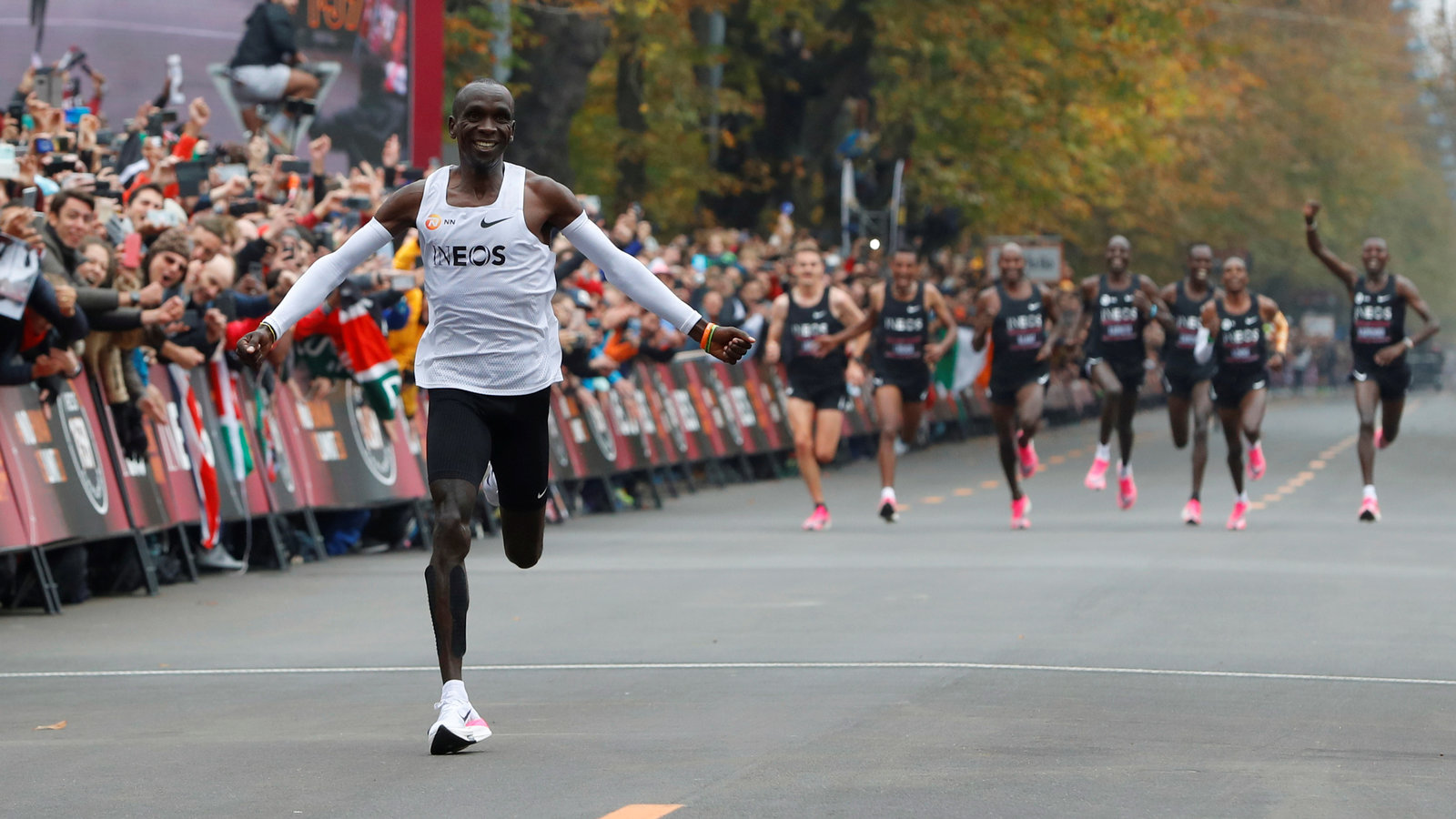

Featured
How To Train For An Ultra Marathon
Modified: January 22, 2024
Discover the best training tips and techniques for running an ultra marathon. Get featured in your next race by following our expert guide.
Introduction
Welcome to the world of ultra-marathons, where running distances of 50 kilometers or more is the norm. If you’re ready to take your running journey to the next level and challenge your physical and mental limits, then training for an ultra-marathon is the ultimate test. Whether you’re a seasoned runner looking to push your boundaries or a newbie seeking an awe-inspiring goal, this comprehensive guide will equip you with the knowledge and strategies to train effectively for an ultra-marathon.
Training for an ultra-marathon requires a unique approach compared to traditional marathon training. It demands a combination of physical endurance, mental fortitude, and meticulous preparation. This article will delve into the various aspects of ultra-marathon training, from goal setting to injury prevention, to help you navigate the exhilarating and grueling journey ahead.
As you embark on this extraordinary endeavor, it’s important to remember that preparing for an ultra-marathon is not a sprint, but a marathon in itself. It requires dedication, consistency, and a gradual progression in training. Your ultimate goal is not just to cross the finish line but to enjoy the journey, push your limits, and discover the extraordinary strength within you.
So lace up your running shoes, brace yourself for the challenges ahead, and let’s dive into the world of ultra-marathon training!
Setting Your Goal
When training for an ultra-marathon, it’s essential to set realistic yet challenging goals. Your goal serves as the guiding force that keeps you motivated and focused throughout your training journey. Here are some key considerations for setting your ultra-marathon goal:
Distance: Choose the distance that aligns with your experience level and aspirations. Ultra-marathons range from 50 kilometers to 100 miles or more. If you’re new to ultra-running, starting with a shorter distance like a 50K or 50 miles can be a great entry point.
Timeframe: Determine the timeframe you have available for training. Consider your work and personal commitments, as well as any other races or events you may want to participate in. Be realistic about the amount of time you can commit to training each week.
Specificity: Set a clear and specific goal. Instead of just aiming to finish the race, consider setting a time goal or targeting a specific ranking within your age group. Having a specific goal will give you a sense of purpose and help you stay motivated during challenging moments in your training.
Challenges: Consider the unique challenges of the race you’ve chosen. Factors such as elevation gain, terrain, and weather conditions can greatly impact your training and race strategy. Make sure your goal aligns with these challenges and takes them into account.
Gradual Progression: If you’re new to ultra-running, it’s important to set progressive goals that gradually increase in distance. This will allow your body to adapt and reduce the risk of injury. Aim to complete shorter trail races or marathons as stepping stones towards your ultimate ultra-marathon goal.
Flexible and Adjust Your Goals: Remember that goals aren’t set in stone. As you progress through your training, be open to adjusting your goals based on your performance, readiness, and any unforeseen circumstances. Flexibility is key in adapting your training plan to suit your needs and capabilities.
Accountability and Support: Share your goals with others, join running groups, or find a training partner. Having support and accountability can keep you motivated and on track, especially during challenging times. Surround yourself with like-minded individuals who understand and support your ultra-marathon goals.
Setting a clear and realistic goal will provide you with direction and focus throughout your ultra-marathon training. It will be your guiding light as you face the challenges and celebrate the victories along the way.
Creating a Training Schedule
A well-structured training schedule is key to preparing your body and mind for the demands of an ultra-marathon. Here’s how to create an effective training schedule:
Assess Your Current Fitness Level: Before diving into a training plan, assess your current fitness level to determine your starting point. Evaluate your endurance, strength, and running pace to understand where you stand and how much progress you need to make.
Gradual Build-Up: Ultra-marathon training requires a gradual increase in mileage and intensity. Start with a foundation phase that focuses on building endurance and gradually increasing the duration and distance of your long runs. Allow ample time for your body to adapt to the increased workload.
Weekly Mileage: Determine the weekly mileage you can comfortably handle and gradually increase it by 10-15% each week. Aim to include a mix of shorter recovery runs, mid-distance runs, and long runs in your weekly schedule. Increase your long run distance by 1-2 miles every other week.
Rest Days: Allow for rest days in your schedule to give your body time to recover and prevent overtraining. Rest days are just as important as training days and help in injury prevention and maintaining optimal performance. Listen to your body and adjust your training schedule accordingly.
Long Runs: Incorporate long runs into your training schedule to simulate the physical and mental demands of the ultra-marathon. Increase the distance of your long runs gradually, with some runs reaching or slightly exceeding the distance of your target race. Include some back-to-back long runs to prepare for the physical challenges of running multiple days in a row.
Quality Workouts: Include interval training, hill repeats, and tempo runs in your training schedule to improve speed, strength, and endurance. These workouts should be done once or twice a week to enhance your overall performance. Gradually increase the intensity and duration of these workouts over time.
Listen to Your Body: Pay attention to how your body responds to training. It’s normal to experience fatigue, muscle soreness, and aches as your mileage increases, but be cautious of any persistent or severe pain. Adjust your training schedule or seek professional advice if necessary.
Cross-Training: Incorporate cross-training activities such as cycling, swimming, or strength training into your schedule. Cross-training helps to improve overall fitness, prevent injuries, and provide variety in your training routine. Aim for 1-2 cross-training sessions per week.
Periodization: Structure your training schedule with periodization, which involves dividing your training into phases of different focuses. This approach helps prevent plateauing and ensures that you peak at the right time for your target ultra-marathon.
Record and Evaluate: Keep a training log to track your progress and evaluate your performance. Note down your mileage, time, how you felt during the run, and any additional observations. This will help you identify patterns, make adjustments to your training, and track improvements over time.
Remember to be flexible and adaptable with your training schedule. Life happens, and unexpected events may require adjustments. Listen to your body, adapt your schedule when needed, and stay committed to your long-term goal. With a well-structured training schedule, you’ll be on the path to ultra-marathon success.
Building Endurance
Developing endurance is crucial for ultra-marathon training as it allows your body to sustain the prolonged physical exertion required to complete the race. Here are some strategies to help you build endurance:
Gradual Progression: Start by gradually increasing your weekly mileage and the duration of your long runs. Aim to increase your total weekly mileage by 10-15% each week. This gradual progression allows your body to adapt to the increased demands and reduces the risk of injury.
Long Runs: Incorporate long runs into your training schedule. These runs should be done at a comfortable pace and gradually increase in distance over time. Focus on time on your feet rather than speed, as endurance is the main objective. The goal is to build up your ability to run for an extended period without tiring quickly.
Back-to-Back Runs: Include back-to-back runs in your training to simulate running on fatigued legs. This helps develop mental and physical resilience, which is essential for tackling the later stages of an ultra-marathon. For example, you could do a long run on Saturday followed by a shorter recovery run on Sunday.
Hill Training: Incorporate hill training into your schedule to improve both strength and endurance. Running uphill challenges your cardiovascular system and leg muscles, helping you build the necessary stamina for the race. Gradually increase the incline and duration of your hill workouts over time.
Cross-Training: Engage in cross-training activities that also improve your endurance, such as cycling or swimming. These activities provide variety, reduce the risk of overuse injuries, and help build overall aerobic fitness.
Slow and Steady: During your long runs and training sessions, maintain a conversation pace. This means being able to hold a conversation while running, indicating that you’re running at an intensity that allows for sustainable endurance building. Avoid the temptation to push the pace too hard, as it can lead to burnout or injury.
Time on Feet: Alongside increasing your mileage, focus on spending more time on your feet. If you’re aiming for a specific race time, gradually increase the length of your long runs until you are running close to your expected race time. This will help your body acclimate to the time and effort required for the race.
Consistency: Consistency is key when it comes to building endurance. It’s better to run consistently at a lower intensity rather than pushing yourself too hard and risking burnout or injury. Make running a regular part of your routine, and aim for a balance between challenging workouts and proper recovery.
Mental Resilience: Don’t overlook the importance of mental strength in building endurance. Train your mind to stay focused and push through tough moments during training. Find techniques that help you stay positive and motivated, such as visualization, setting smaller milestones within a long run, or using positive affirmations.
Building endurance takes time and dedication, but with consistent training and a gradual progression, you’ll be able to develop the stamina needed to conquer your ultra-marathon goal. Remember to listen to your body, rest when needed, and trust in the process of building your endurance over time.
Incorporating Interval Training
Interval training is a valuable tool in your ultra-marathon training arsenal as it improves your speed, stamina, and overall race performance. By alternating between intense bursts of effort and recovery periods, interval training helps you become a more efficient and resilient runner. Here’s how to incorporate interval training into your training plan:
Choose the Right Distance and Intensity: Select intervals distances that are appropriate for your race distance and fitness level. For example, if you’re training for a 50K, intervals ranging from 400 to 1600 meters can be beneficial. For shorter races, shorter interval distances like 200 to 800 meters may be more suitable.
With regards to intensity, your intervals should be run at a pace that is faster than your race pace, challenging but sustainable. This will vary depending on your fitness level and the specific intervals you’re performing.
Select Interval Types: There are various types of interval workouts you can incorporate into your training plan:
- Traditional Intervals: These involve running at a high intensity for a set distance or time followed by a recovery period of jogging or walking. For example, you can run 800 meters at a fast pace followed by 400 meters of easy jogging or walking to recover. Repeat the cycle for a specific number of intervals.
- Pyramids: Pyramids involve gradually increasing and then decreasing the distance or time of your intervals. For example, you can start with 200 meters, increase to 400 meters, then 800 meters, and then decrease back down to 400 meters and 200 meters. This helps build both speed and endurance.
- Timed Intervals: Instead of focusing on distance, you can perform interval workouts based on time. For instance, you can run at a hard effort for 2 minutes followed by an easy recovery jog for 1 minute. Repeat this cycle for a specific number of intervals.
- Fartlek Runs: Fartlek runs involve incorporating intervals into your regular runs. During a fartlek run, you can pick landmarks such as lampposts or trees and run at a faster pace until you reach the landmark, and then recover until the next landmark. This adds an element of spontaneity and fun to your training.
Recovery Periods: Allow for sufficient recovery periods between intervals. The duration of the recovery will depend on the intensity and length of your intervals. Aim for a recovery period that allows you to catch your breath and lower your heart rate before starting the next interval. As you progress in your training, you can experiment with different recovery durations to challenge yourself further.
Frequency: Incorporate interval training into your training plan once or twice a week. This frequency allows for adequate recovery and ensures that you can maintain the quality of your intervals. Avoid consecutive interval training days to prevent overuse injuries and give your body time to recover.
Warm-Up and Cool-Down: Prioritize a proper warm-up and cool-down for your interval sessions. This includes dynamic stretching, light jogging, and mobility exercises to prepare your body for the intense effort ahead. Similarly, cool down with easy jogging or walking to gradually lower your heart rate and prevent muscle soreness.
Progression: Gradually increase the intensity and duration of your intervals as your fitness improves. This could include running the intervals at a faster pace or increasing the number of intervals within a session. Progressive overload is important for continued improvement and challenging your limits.
Listen to Your Body: As with any training, it’s crucial to listen to your body and be mindful of signs of overtraining or injury. If you’re experiencing persistent pain or fatigue, it’s important to adjust your interval training or seek professional advice. Consistency and staying injury-free are paramount to a successful ultra-marathon training journey.
By incorporating interval training into your routine, you’ll develop the speed, endurance, and mental fortitude needed to conquer your ultra-marathon goals. Embrace the challenge, push yourself outside your comfort zone, and watch as your performance soars.
Strengthening Your Core
When it comes to ultra-marathon training, having a strong core is essential for maintaining proper running form, improving stability, and preventing injuries. A strong core helps to distribute the impact forces generated during running and allows you to efficiently transfer power between your upper and lower body. Here are some effective ways to strengthen your core:
Plank Exercises: Planks are a staple core exercise that targets multiple muscles in your abdomen, lower back, and hips. Begin by assuming a push-up position, supporting your body on your forearms and toes. Keep your body in a straight line, engage your core, and hold the position for a set amount of time. Aim to gradually increase the duration as your strength improves.
Leg Raises: Leg raises target your lower abdominal muscles. Lie flat on your back with your arms extended by your sides. Slowly lift your legs together towards the ceiling until they are perpendicular to the floor, then lower them back down in a controlled manner. To increase the challenge, you can add ankle weights or perform the exercise on a stability ball.
Flutter Kicks: Flutter kicks engage your lower abs, hip flexors, and quadriceps. Lie on your back with your legs extended and your hands tucked under your glutes. Lift your heels a few inches off the ground and alternate kicking your legs up and down in a controlled motion. Maintain a strong core and focus on engaging your lower abdominal muscles throughout the exercise.
Russian Twists: Russian twists target your obliques, which provide rotational stability during running. Sit on the ground with your knees bent and your feet lifted off the ground. Hold a weight or a medicine ball in front of your chest, and twist your torso from side to side, touching the weight to the ground on each side. To increase difficulty, lift your feet higher off the ground or hold the weight further away from your body.
Supermans: Supermans strengthen the muscles in your lower back, which play a crucial role in maintaining proper posture and stability during running. Lie face down with your arms extended in front of you and your legs straight behind you. Simultaneously lift your arms and legs off the ground, keeping your core engaged. Hold for a few seconds and then lower back down. Repeat for the desired number of repetitions.
Pilates and Yoga: Classes or routines that focus on core stability, such as Pilates and yoga, can be excellent additions to your training routine. These exercises not only strengthen your core but also improve flexibility, balance, and body awareness.
Functional Exercises: Incorporate functional exercises that mimic the movements and demands of running. Exercises like deadlifts, lunges, squats, and kettlebell swings engage your core muscles while also targeting other major muscle groups. This helps develop overall strength and stability that translates to better running performance.
Consistency: Consistency is key when it comes to strengthening your core. Aim to include core exercises in your training routine at least two to three times a week. Dedicate a specific time or day for core workouts to ensure that it becomes an integral part of your training program.
Progression: As your core strength improves, gradually increase the difficulty or intensity of the exercises. This can involve adding resistance, increasing repetitions, or trying more advanced variations of the exercises. Continuously challenging your core will lead to continued improvement and enhanced performance.
Proper Form: Pay attention to proper form and technique during core exercises. Maintaining a neutral spine, engaging your core, and avoiding excessive strain on your neck or lower back is crucial. If necessary, seek guidance from a qualified fitness professional to ensure that you are performing the exercises correctly and safely.
By incorporating core-strengthening exercises into your ultra-marathon training program, you’ll develop the stability and strength necessary to run with optimal efficiency and reduce the risk of injuries. Remember, a strong core is the foundation for maximizing your running performance and achieving your ultra-marathon goals.
Cross-Training
Cross-training is a valuable component of any comprehensive ultra-marathon training plan. It involves engaging in activities other than running to improve overall fitness, prevent overuse injuries, and add variety to your training routine. Here’s how you can incorporate cross-training into your ultra-marathon preparations:
Choose Complementary Activities: Select cross-training activities that complement your running training. Aim for activities that improve cardiovascular fitness, build strength, enhance flexibility, and promote recovery. Some popular cross-training options include cycling, swimming, rowing, hiking, yoga, Pilates, and strength training.
Diversify Your Cardiovascular Workout: Engaging in aerobic exercises that elevate your heart rate and challenge your cardiovascular system is essential. These activities improve your endurance and cardiovascular capacity, which translates to enhanced running performance. Opt for cycling, swimming, or rowing as they provide low-impact alternatives to running while still providing an effective cardiovascular workout.
Strength Training: Incorporate strength training into your cross-training routine to build muscular strength, power, and stability. Focusing on exercises that target the major muscle groups used in running, such as the legs, core, and upper body, can help improve your overall running economy and prevent muscle imbalances. Include exercises like squats, lunges, deadlifts, planks, and push-ups for a well-rounded strength training program.
Flexibility and Mobility Work: Don’t overlook the importance of flexibility and mobility in your training. Activities such as yoga and Pilates help increase your range of motion, improve posture, and enhance muscular balance. These exercises can also aid in recovery, reduce muscle soreness, and prevent injury. Incorporate dynamic stretching and mobility exercises into your warm-up routine and dedicate specific sessions to focused stretching and mobility work.
Active Recovery: Cross-training can also be used as a form of active recovery. Engaging in low-intensity activities like swimming, walking, or gentle cycling on your rest days can help promote circulation, aid in muscle recovery, and rejuvenate your body for upcoming training sessions. Active recovery exercises help to reduce muscle soreness and maintain fitness without putting excessive stress on your body.
Listen to Your Body: As with any form of training, it’s important to listen to your body and avoid overtraining. Cross-training should complement your running training, not interfere with it. Pay attention to how your body responds to different activities and adjust your cross-training routine as needed. If you’re feeling fatigued or experiencing any pain or discomfort, take a break or opt for a lower-impact activity to allow for proper recovery.
Periodization: Incorporate the principles of periodization into your cross-training routine. Vary the intensity, duration, and type of cross-training activities throughout your training plan to continually challenge your body and prevent plateaus. For example, you can focus on more strength training during the off-season or base-building phase and increase cardiovascular cross-training closer to your race date.
Experiment with New Activities: Use cross-training as an opportunity to explore new activities that you may enjoy. Trying different sports or exercises not only keeps your workouts interesting but also allows you to develop a more well-rounded fitness routine. It can also provide a mental break from running while still maintaining your fitness level.
Cross-training offers a multitude of benefits to ultra-marathon runners, including improved overall fitness, injury prevention, enhanced recovery, and the opportunity to diversify your training routine. By incorporating cross-training intelligently and listening to your body, you’ll be well on your way to achieving your ultra-marathon goals.
Nutrition and Hydration
Proper nutrition and hydration are essential components of ultra-marathon training. A well-designed eating plan and hydration strategy can optimize your performance, aid in recovery, and help you sustain energy throughout the race. Here are some key considerations for nutrition and hydration during your ultra-marathon journey:
Establish a Balanced Diet: Focus on consuming a balanced diet that includes a variety of nutrient-dense foods. Fuel your body with complex carbohydrates, lean proteins, healthy fats, and an abundance of fruits and vegetables. These nutrients provide the necessary energy and essential nutrients to support your training and recovery.
Pre-Race Nutrition: Pay attention to your pre-race meals. Aim to have a carbohydrate-rich meal a few hours before your long runs or race day. Include easily digestible foods like oatmeal, bananas, and whole grain toast to provide sustained energy. Avoid trying new foods on race day, and instead, stick to foods that you have tried and tested during your training.
During-Run Nutrition: Practice your fueling strategy during your long runs to determine what works best for you. Fuel your body with easily digestible carbohydrates during your runs to maintain energy levels. This can include energy gels, chews, sports drinks, or whole foods like dates or pretzels. Stay hydrated by consuming fluids at regular intervals, such as water or electrolyte-rich drinks.
Post-Run Recovery: Proper post-run recovery nutrition is vital for replenishing glycogen stores and promoting muscle repair. Consume a combination of carbohydrates and protein within 30 to 60 minutes after your run to kickstart the recovery process. An ideal post-run snack could include a banana with nut butter or a protein shake with a piece of fruit.
Hydration Strategies: Maintain proper hydration throughout your training and on race day. Pay attention to your body’s thirst signals and drink fluids at regular intervals. Develop a hydration plan that ensures you consume enough fluids without overhydrating or risking hyponatremia. Consider weighing yourself before and after long runs to gauge your fluid loss, and adjust your hydration strategy accordingly.
Electrolyte Balance: Electrolytes, such as sodium, potassium, and magnesium, play a crucial role in maintaining fluid balance and muscular function. During prolonged exercise, electrolytes are lost through sweat and need to be replenished. Consume electrolyte-rich drinks or use electrolyte supplements to maintain proper balance during your runs. Experiment with different options during your training to find what works best for you.
Listen to Your Body: Every runner is unique, and individual hydration and nutrition needs can vary. Listen to your body and pay attention to its cues. If you feel thirsty, drink. If you feel fatigued or experience stomach discomfort, adjust your fueling strategy. It’s important to find a balance that works for you and allows you to perform at your best.
Practice Makes Perfect: Use your long training runs as an opportunity to practice your nutrition and hydration strategies. Experiment with different types of fuel, beverages, and timing to determine what works best for your body. The more you practice, the better you’ll understand your body’s needs and be prepared for race day.
Consult with a Professional: If you’re uncertain about your nutrition and hydration needs during ultra-marathon training, consult with a registered dietitian or sports nutritionist. They can provide personalized guidance and help develop a nutrition plan tailored to your specific goals and requirements.
Nutrition and hydration are vital aspects of ultra-marathon training. A well-thought-out plan will fuel your body, optimize performance, and promote a successful race day experience. By prioritizing proper nutrition and hydration, you’ll be better equipped to handle the physical demands of ultra-marathons and reach your full potential as a runner.
Rest and Recovery
Rest and recovery are essential components of any ultra-marathon training plan. Proper rest allows your body to repair and strengthen itself, preventing overuse injuries and ensuring that you perform at your best on race day. Here are some key considerations for incorporating rest and recovery into your training:
Quality Sleep: Aim for seven to nine hours of quality sleep each night. Sleep is crucial for muscle repair, hormone regulation, and overall recovery. Create a sleep routine that promotes restful sleep, such as avoiding electronic devices before bed, keeping your sleep environment cool and dark, and establishing a consistent sleep schedule.
Active Rest Days: Incorporate active rest days into your training schedule. These are days where you engage in light activity such as walking, yoga, or stretching to promote blood flow and aid in recovery. Active rest days provide a mental break from intense workouts while still keeping your body active.
Recovery Runs: Include shorter, easy-paced recovery runs in your training plan. These runs help flush out metabolic waste, increase blood flow, and promote healing in your muscles. Keep the pace conversational and enjoy the lower intensity effort. Recovery runs aid in recovery and prepare your body for the next challenging training session.
Foam Rolling and Self-Massage: Use foam rollers, massage balls, or other self-massage tools to target sore muscles and release muscular tension. Foam rolling helps improve circulation, reduces muscle tightness, and promotes recovery. Incorporate a few minutes of foam rolling after workouts or before bed to reap the benefits.
Ice Baths and Cold Therapy: Consider incorporating ice baths or cold therapy into your recovery routine. Submerging your body in cold water helps reduce inflammation, minimize muscle soreness, and speed up recovery. After intense workouts or long runs, taking a 10-15-minute ice bath can be beneficial. Alternatively, you can use cold packs or ice packs on specific areas of your body for targeted cold therapy.
Proper Nutrition: Adequate nutrition plays a vital role in recovery. Consume a balanced diet consisting of quality carbohydrates, proteins, and healthy fats to provide your body with the necessary nutrients for repair and replenishment. Include foods rich in antioxidants to help fight inflammation and enhance recovery.
Hydration: Hydrate properly throughout the day, not just during training sessions. Staying adequately hydrated aids in recovery by facilitating nutrient transport, promoting cellular function, and aiding in waste removal. Drink water and electrolyte-rich beverages regularly to maintain optimal hydration levels.
Periodization: Incorporate planned rest and recovery periods into your training plan. Including recovery weeks or lighter training phases allows your body to recharge and adapt to the stress of training. These periods provide an opportunity for physical and mental rejuvenation, setting the stage for improved performance.
Listen to Your Body: Pay attention to your body’s signals and adjust your training as needed. If you’re feeling excessively fatigued, experiencing persistent pain, or have decreased motivation, it may be a sign that you need additional rest. Be mindful of the difference between pushing through fatigue and overtraining.
Self-Care Strategies: Engage in self-care activities that support your overall well-being. This may include activities such as meditation, deep breathing exercises, taking relaxing baths, or practicing yoga. Prioritizing self-care enhances not only your physical recovery but also your mental and emotional well-being.
Mental Rest: Ultra-marathon training is demanding both physically and mentally. Allow yourself mental rest days where you disconnect from training-related thoughts and activities. Engage in hobbies, spend time with loved ones, or pursue activities that bring you joy and relaxation. Mental rest is just as important as physical rest for maintaining motivation and mental clarity.
Remember, rest and recovery are not signs of weakness but essential components of optimal performance. By prioritizing rest and recovery, you provide your body with the time it needs to rebuild and come back stronger. Embrace the rest days, listen to your body, and enjoy the rejuvenation that comes with proper recovery.
Mental Preparation
Preparing yourself mentally is just as crucial as physical training when it comes to ultra-marathon running. The mental challenges of covering long distances require mental fortitude, resilience, and a positive mindset. Here are some strategies to help you develop mental strength and prepare yourself mentally for the demands of an ultra-marathon:
Set Realistic Expectations: Understand that an ultra-marathon is a significant challenge, and it’s normal to face tough moments during the race. Set realistic expectations for yourself and accept that it might be physically and mentally demanding. This mindset will help you stay focused and motivated when faced with difficult situations.
Visualize Success: Use visualization techniques to mentally rehearse successful race scenarios. Close your eyes and vividly imagine yourself crossing the finish line, feeling strong, and overcoming any obstacles. Visualizing success boosts confidence, reduces anxiety, and helps you believe in your ability to achieve your goals.
Develop Positive Self-Talk: Practice positive self-talk to cultivate a positive mindset. Replace negative thoughts and doubts with encouraging and empowering statements. Remind yourself of your past accomplishments, strengths, and the hard work you’ve put into your training. Train your mind to focus on the positive aspects of your performance, and use affirmations to reinforce your belief in yourself.
Break it Down: Rather than getting overwhelmed by the distance of the ultra-marathon, break it down mentally into smaller, manageable segments. Focus on one aid station, one mile, or one landmark at a time. This approach helps keep you mentally engaged and prevents feelings of being overwhelmed by the overall distance.
Practice Mindfulness: Incorporate mindfulness techniques into your training and race day. By staying present and focusing on the current moment, you can maintain a calm and clear mindset. Practice deep breathing exercises or mindfulness meditation during your training to strengthen your mental focus and develop a sense of calmness under pressure.
Be Adaptable: Understand that race day conditions may not always go as planned. Be adaptable and ready to adjust your strategy if needed. Mentally prepare yourself for unforeseen circumstances, such as changes in weather or unexpected challenges on the race course. Having a flexible mindset will help you stay resilient and problem-solve effectively.
Find Motivation: Identify your sources of motivation and inspiration. This could be dedicating your race to a loved one, running for a charitable cause, or drawing inspiration from other ultra-marathoners. Find ways to remind yourself of why you started this journey and the immense sense of accomplishment that awaits you at the finish line.
Use Mantras or Affirmations: Develop a personal mantra or positive affirmation that resonates with you. Repeat it to yourself during challenging moments to stay motivated and focused. Your mantra can be as simple as “I am strong and capable” or “One step at a time.” These affirmations can boost your confidence and provide a mental anchor when the going gets tough.
Practice Mental Resilience: Training your mental resilience is as important as training your physical endurance. Push your limits in training, expose yourself to uncomfortable situations, and practice getting comfortable with being uncomfortable. This will help you build mental toughness and prepare you to handle the mental challenges that arise during the ultra-marathon.
Celebrate Milestones: Break your training down into smaller milestones and celebrate each one you achieve. Recognize and acknowledge your progress and achievements along the way. This positive reinforcement boosts your confidence and keeps you motivated and engaged throughout the training process.
Seek Support: Surround yourself with a supportive community of fellow runners, friends, and family who understand and encourage your ultra-marathon goals. Share your challenges, victories, and concerns with them. Their support and understanding can provide a valuable source of motivation and reassurance.
Mental preparation is a vital aspect of your ultra-marathon journey. By practicing these strategies, cultivating a positive mindset, and training your mental resilience, you’ll be better equipped to overcome challenges, stay focused, and ultimately achieve your goals. Remember, a strong mind is just as important as a strong body in the world of ultra-marathon running.
Gear and Equipment
When training for an ultra-marathon, having the right gear and equipment can greatly enhance your performance, comfort, and overall experience. Here are some key considerations for selecting the appropriate gear and equipment:
Running Shoes: Invest in a pair of high-quality running shoes that suit your foot type and running style. Visit a specialized running store to get properly fitted and find a shoe with the right amount of cushioning, support, and fit. Train in the same type of shoes you plan to wear on race day to ensure optimal comfort and prevent unnecessary blisters or injuries.
Apparel: Choose moisture-wicking and breathable apparel that suits the weather conditions you’ll be running in. Wear technical fabrics that help manage sweat and keep you dry. Opt for lightweight and comfortable clothing that allows for freedom of movement. Consider wearing compression gear to aid in muscle recovery and reduce fatigue.
Socks: Select high-quality, moisture-wicking socks that provide cushioning and prevent blisters. Look for socks made with materials that reduce friction, keep feet dry, and provide arch support.
Hydration Systems: Invest in a hydration system that suits your preferences and race requirements. Options include handheld water bottles, hydration belts, or hydration vests. Consider the capacity, comfort, and accessibility when choosing a hydration system. Practice using your chosen system during training to ensure it works well for you.
Nutrition Accessories: Depending on your fueling strategy, you may need accessories such as energy gels, chews, or a fuel belt for carrying your nutrition. Experiment during your training to find the products and accessories that work best for you.
GPS Watch or Running App: Track your training and monitor your progress with a GPS watch or running app. These devices provide valuable data such as distance, pace, heart rate, and elevation. Choose a device that suits your needs and preferences, and practice using it during your training runs.
Headlamp or Reflective Gear: If you’ll be running in low-light conditions or during nighttime hours, invest in a headlamp or wear reflective gear to ensure your visibility to others. Safety should always be a priority, so make sure you can be seen by motorists and other runners.
Weather-Appropriate Gear: Prepare for various weather conditions by having gear suitable for rain, wind, heat, or cold. Pack a lightweight waterproof jacket, a hat or visor for sun protection, and layers for temperature changes. Plan ahead and check the weather forecast to ensure you’re adequately prepared.
Body Glide or Anti-Chafing Products: Protect your skin from chafing or blisters by applying a suitable anti-chafing product such as Body Glide or petroleum jelly to areas prone to friction. This will ensure a more comfortable running experience, especially during long distances.
Emergency and First Aid Kit: Carry a small emergency kit that includes essentials such as bandages, antiseptic wipes, blister care products, and any necessary medications. It’s better to be prepared for minor injuries or ailments that may arise during training or on race day.
Practice and Test: Train with your gear and equipment during your long runs and race simulations. This allows you to identify any discomfort, areas that require adjustment, or items that need replacing. Testing your gear beforehand will help prevent any surprises or issues on race day.
Replace and Rotate: Regularly assess the condition of your gear and equipment. Shoes, socks, and other items may need to be replaced due to wear and tear. Rotating different pairs of shoes or gear during training can help prevent overuse injuries and provide variety.
Comfort and Personal Preference: Ultimately, choose gear and equipment that you find comfortable and align with your personal preference. What works for one runner may not work for another, so listen to your body and make choices that support your comfort and performance.
Investing in the right gear and equipment can make a significant difference in your ultra-marathon training and racing experience. Take the time to choose wisely, practice using your gear, and make any necessary adjustments to ensure you’re fully prepared to tackle your ultra-marathon challenge.
Injury Prevention and Management
When training for an ultra-marathon, prioritizing injury prevention and effectively managing any injuries that may arise is crucial to ensure a successful and enjoyable experience. Here are some key strategies for injury prevention and management:
Gradual Progression: Avoid the temptation to increase mileage or intensity too quickly. Gradually increase your training volume and intensity to allow your body to adapt and reduce the risk of overuse injuries. Stick to the 10% rule, which suggests increasing your mileage by no more than 10% per week.
Listen to Your Body: Pay attention to any signs of pain, discomfort, or fatigue. Recognize the difference between muscular fatigue and more serious pain that could indicate an injury. If you experience persistent pain during a run, it’s important to stop and assess the situation to prevent further damage.
Cross-Training and Strength Training: Incorporate cross-training activities and strength training into your routine. Cross-training helps reduce the repetitive stress on specific muscles and joints, while strength training helps improve muscular strength, stability, and overall resilience. Focus on exercises that target the muscles used in running, such as your core, hips, glutes, and lower limbs.
Proper Warm-Up and Cool-Down: Always warm up before starting your runs and cool down afterward. Perform dynamic stretches, light jogging, or mobility exercises to prepare your muscles and joints for the demands of running. Cooling down with gentle stretching and foam rolling helps promote muscle recovery and reduce muscle soreness.
Stretching and Mobility Work: Incorporate regular stretching and mobility exercises in your routine to improve flexibility and joint mobility. This can help prevent muscle imbalances, enhance running mechanics, and reduce the risk of injuries. Focus on areas prone to tightness, such as the calves, hamstrings, hips, and IT band.
Appropriate Footwear: Wear running shoes that provide the right amount of support, cushioning, and stability for your foot type and running style. Replace your shoes regularly, typically every 300-500 miles, to ensure optimal shock absorption and minimize the risk of overuse injuries.
Proper Running Form: Focus on maintaining proper running form to reduce the strain on your body. Ensure a relaxed upper body, with arms swinging naturally and a slight forward lean from the ankles. Avoid overstriding and aim for a midfoot strike, allowing your feet to land under your center of gravity.
Rest and Recovery: Allow for sufficient rest and recovery between training sessions. Rest days are essential for muscle repair, tissue adaptation, and overall recovery. Strive for a balance between training and adequate rest to prevent overtraining and the associated risk of injury.
Treat Injuries Promptly: If you do experience an injury, seek professional guidance and treat it promptly. Rest, ice, compression, and elevation (RICE) can be effective for initial injury management. If symptoms persist or worsen, consult a healthcare professional or physical therapist for an accurate diagnosis and appropriate treatment plan.
Seek Professional Advice: If you’re unsure about training techniques, injury prevention, or how to manage existing injuries, consult with a qualified professional such as a physical therapist or sports medicine specialist. They can provide personalized advice, recommend specific exercises, and guide you through a safe and effective training plan.
Maintain a Balanced Lifestyle: Adopt a balanced lifestyle that supports your training. Get enough sleep, fuel your body with nutritious foods, manage stress levels, and prioritize relaxation and self-care. A well-rounded approach to health and wellness contributes to injury prevention and overall well-being.
Prioritize Your Long-Term Health: Remember that ultra-marathon training is a long-term journey. Prioritize your long-term health by listening to your body, being mindful of proper training progression, and seeking help when needed. Taking care of your body and preventing injuries ensures that you can continue to pursue your running goals for years to come.
By implementing these injury prevention and management strategies, you’ll minimize the risk of injuries and maximize your chances of completing your ultra-marathon training journey successfully. Prioritize your physical well-being, listen to your body, and take a proactive approach to injury prevention for a safe and rewarding experience.
Race Day Strategies
On the day of your ultra-marathon, implementing effective race day strategies can make a significant difference in your overall performance and experience. Here are some key strategies to help you navigate race day successfully:
Stick to Your Routine: Stick to the routine you’ve practiced during your training. Eat a familiar pre-race meal that provides sustained energy, hydrate adequately, and follow your warm-up routine. Familiarity helps reduce pre-race nerves and keeps you focused on the task at hand.
Pace Yourself: Start the race at a controlled and sustainable pace. Avoid getting caught up in the excitement of the race and resist the urge to go out too fast. Beginning at a moderate pace will conserve energy for the later stages of the race when fatigue sets in.
Break it Down: Mentally divide the race into smaller segments or aid stations. Focus on reaching these milestones rather than thinking about the entire distance. Celebrate each milestone as a small victory and gradually work your way through the course.
Hydration and Fueling: Stay disciplined with your hydration and fueling strategy. Regularly drink fluids at aid stations to stay hydrated. Consume your planned nutrition, whether it’s energy gels, chews, or whole foods, at consistent intervals to maintain energy levels. Practice your fueling strategy during training to ensure its effectiveness on race day.
Adapt to Course Conditions: Be adaptable and adjust your race strategy based on the specific course conditions. If the terrain is hilly, conserve energy on the uphills and make up time on the downhills. If running in extreme heat or cold, adjust your pace and hydration accordingly. Be prepared to switch gears and make decisions on the fly.
Run Your Own Race: Avoid comparing yourself to others and focus on running your own race. Stay true to your training, trust in your preparation, and stick to your race plan. It’s easy to get caught up in the performance of others, but maintaining your own pace and strategy is key to long-term success.
Stay Mentally Engaged: Keep your mind engaged and focused throughout the race. Set small goals or checkpoints to work toward. Use mental cues, such as focusing on your form, repeating positive affirmations, or dedicating each mile to someone or something meaningful. Stay mentally present to overcome any moments of doubt or fatigue.
Enjoy the Experience: Remember to enjoy the race day experience. Take in the beautiful scenery, the camaraderie of fellow runners, and the incredible achievement of participating in an ultra-marathon. Smile, thank volunteers along the course, and soak in the atmosphere. It’s a celebration of your hard work and dedication.
Stay Positive: Believe in yourself and maintain a positive mindset. Remain resilient in the face of challenges and setbacks. If negative thoughts creep in, replace them with positive affirmations and reminders of why you embarked on this journey. Your mental attitude can greatly impact your physical performance.
Expect and Embrace Challenges: Accept that challenges will arise during an ultra-marathon. Mental and physical lows are normal. Expect them, and face them head-on with determination. Embrace the difficulties as opportunities to grow stronger, both mentally and physically. Every challenge you overcome will make your accomplishment even more rewarding.
Finish Strong: In the final miles of the race, summon your remaining strength and finish strong. Dig deep and tap into your mental reserves to push through any discomfort. Visualize crossing the finish line and revel in the satisfaction of accomplishing your ultra-marathon goal.
Implementing these race day strategies will help you navigate your ultra-marathon with confidence and determination. With careful pacing, disciplined fueling and hydration, and a positive mindset, you’ll be well-prepared to conquer the challenges and achieve your ultimate goal.
Conclusion
Training for an ultra-marathon is a remarkable journey that tests your physical and mental limits. Throughout this comprehensive guide, we have explored the various aspects of training for an ultra-marathon, from setting your goals to race day strategies. By implementing the strategies and principles outlined in this guide, you will be well-equipped to tackle the challenges and experience the incredible sense of achievement that comes with completing an ultra-marathon.
Remember that ultra-marathon training is not just about the destination but the journey itself. Embrace the process, enjoy the small victories along the way, and stay committed to your training. Be adaptable, listen to your body, and make adjustments as needed. Prioritize proper nutrition, hydration, rest, and recovery to optimize your performance and prevent injuries. Develop mental resilience, stay positive, and visualize success to overcome any obstacles that may come your way.
Surround yourself with a supportive community of fellow runners who understand and share your passion for ultra-marathons. Lean on them for motivation, guidance, and encouragement throughout your training and on race day. Share your experiences and celebrate each other’s achievements.
Above all, remember that completing an ultra-marathon is an incredible accomplishment. It requires dedication, perseverance, and a belief in your abilities. So embrace the challenges, overcome the obstacles, and revel in the sense of accomplishment as you cross the finish line.
Now, lace up your running shoes, trust in your training, and embark on this incredible journey. The road ahead may be long and challenging, but the rewards will be immeasurable. Ultra-marathon training will push you to your limits, but it will also reveal the extraordinary strength and resilience within you.
So go forth, conquer your ultra-marathon goals, and become part of the extraordinary community of ultra-runners who have dared to push beyond their limits. The journey awaits you. Good luck!









